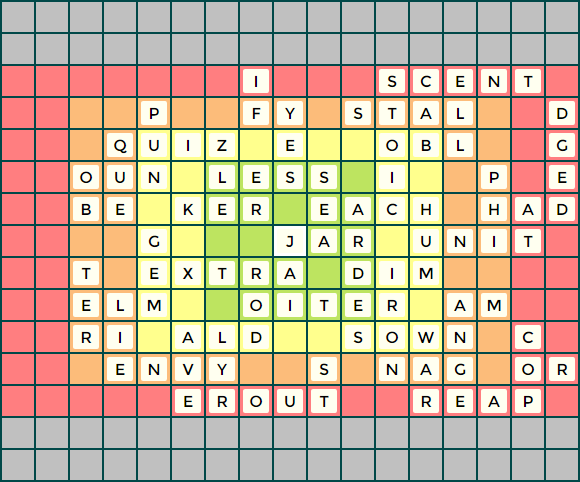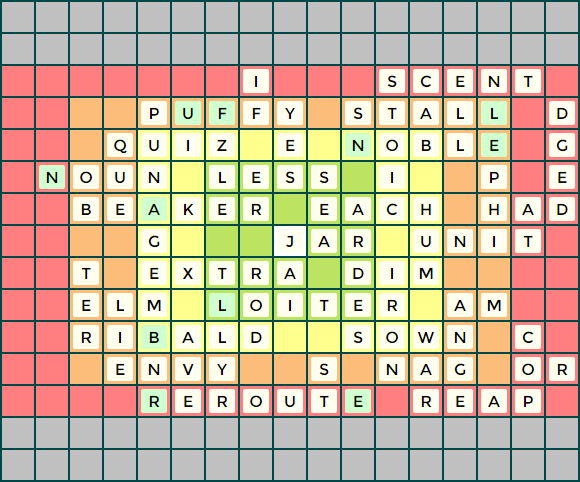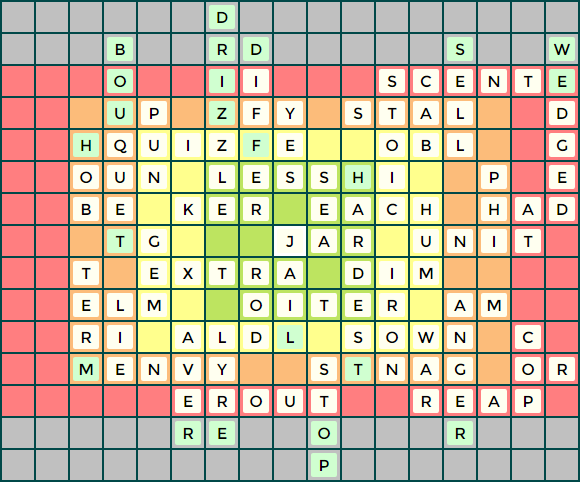Example Game
This is an example game that illustrates each of the rules. In each of the images, the row and column of the most recently placed letter are highlighted. This is important, because the key element of the game is that when a letter is placed, the row and column must work as part of a crossword grid, irrespective of what that does to the rest of the board.The first player places on of their letters in the central square of the board (example board 1):

Example Board 1
The second player then places a letter adjacent to the first (example board 2). The letters must form part of an allowed word. In this case potentially JAM.

Example Board 2
The next player (or back to the first player, depending on how many players there are) then plays, again placing a single letter adjacent to another letter. Play continues and, whenever a letter is placed, all the letters in that row and column must be form part of legitimate words in a crossword grid. Each time a player places a letter they can change the intended word so by placing an I below JA the word now could be JAIL rather than JAM (example board 3).

Example Board 3
When a letter is played the whole row and column must be explainable by the person who placed the letter. When the letter R is played (example board 4), the word(s) on that row could be either OVERSEAS or HER and EACH; both are valid as long as each completed word can be separated by a blank square.

Example Board 4
Placing a letter in the green zone does not incur a penalty. However once a player is unable to place any of their letters on a green square they have to extend the playing area by placing a letter in the yellow zone (example board 5). Placing the I scores that player 1 point.

Example Board 5
Once a letter has been played in a new row or column, other letters can subsequently be played in that row or column without incurring a penalty, up until the point where it opens a previously unplayed row or colum. The C of EACH doesn’t score (example board 6).

Example Board 6
Since only the row and column matter when placing a letter, some squares become unplayable as a different letter would be required in the words running horizontally and vertically. The word running vertically in the next example could be HARDEST, however the H can never be placed because LESSH isn’t part of a valid word (example board 7). Nonetheless all play in this example remains legitimate.

Example Board 7
It is also valid to play part of a word that is never going to be completed. Placing the Z for PUZZLE or DRIZZLE (example board 8) is allowed although the completed word would extend beyond the playable board and into the completion zone. Furthermore, there is only one Z in the letter distribution so the word can’t ever be completed.

Example Board 8
A letter with no adjacent letters does not have to be part of a word, as long as there is sufficient space to complete other words in the row or column and have a space between completed words. In the example above (example board 8) the T in the highlighted column is not part of a vertically running word and although not a word in itself is valid as part of the crossword style grid.

Example Board 9
Play continues until all the letters have been placed or none of the players can legitimately go. The final board has many partially formed words (example board 9).
These final two images show the board – but not as it ever is… These images show the words with the missing letters put in, first the words running horizontally (which ruins some of the words running downwards) and then showing those running vertically (which likewise ruins words that run across the board). The letters highlighted in green can never be placed on the board – they remain imaginary and unplayed.

Completed game - unplayed horizontal letters

Completed game - unplayed vertical letters